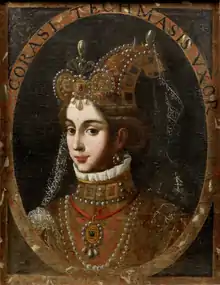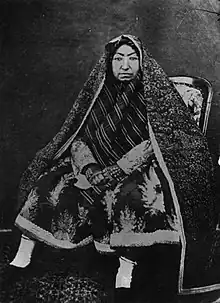List of royal consorts of Persia
This is a list of royal consorts of rulers that held power over Persia (present-day Iran). The title Shahbanu was used for the female ruler or royal consort in certain dynasties, including the Sassanids and Pahlavis.[2] The list is from the establishment of the Median Empire by Medes c. 705 BC until the deposition of the Pahlavi dynasty in 1979.
| Shahbanu of Persia/Iran | |
|---|---|
 Imperial Arms of the Shahbanu of Iran | |
 | |
| Details | |
| Style | Shahbanu bâmbişnân bâmbişn (Queen of Queens)[1] |
| Formation | 678 BC |
| Abolition | 11 February 1979 |
| Residence | Apadana Tachara Palace of Darius Palace of Ardashir Taq Kasra Ālī Qāpū Palace Hasht Behesht Golestan Palace Sa'dabad Palace Niavaran Palace |
| Appointer | Shah or Ruler of Persia |
Teispid kingdom (c.705–559 BC)
| Portrait | Name | Monarch | Notes |
|---|---|---|---|
| Mandana | Cambyses I | [4] | |
Achaemenid Empire (559–334/327 BC)
| Portrait | Name | Monarch | Notes |
|---|---|---|---|
| Cassandane | Cyrus II | [5] | |
| Phaedymia | Cambyses II | [6] | |
| Atossa | Cambyses II (disputed) Darius I |
also a sister of Cambyses II.[7] | |
| Artystone | Darius I | [8] | |
| Parmys | [9] | ||
| Amestris | Xerxes I | [10] | |
| Damaspia | Artaxerxes I | [11] | |
| Parysatis | Darius II | [12] | |
| Stateira | Artaxerxes II | [13] | |
| Amestris | also a daughter of Artaxerxes II.[14] | ||
| Atossa | Artaxerxes III | [15][16] | |
| Stateira | Darius III | [17] |
Macedonian Empire (336–306 BC)
| Portrait | Name | Monarch | Notes |
|---|---|---|---|
| Roxana | Alexander III | [18] | |
| Stateira | [19] | ||
| Parysatis | [20] | ||
| Eurydice | Philip III | [21] | |
Seleucid Empire (311–129 BC)
Parthian Empire (247 BC – AD 228)
| Portrait | Name | Monarch | Notes |
|---|---|---|---|
| Rinnu | Mithridates I | [32] | |
| Ariazate | Gotarzes I | [33] | |
| Laodice | Orodes II | [34] | |
 |
Musa | Phraates IV | later a queen regnant in her own right.[35] |
Sasanian Empire (224–651)
| Portrait | Name | Monarch | Notes |
|---|---|---|---|
| Denag | Ardashir I | also a sister of Ardashir I.[36] | |
| Murrod | [1] | ||
| Khwarranzem | Ardashir I or Shapur I |
[37] | |
| Shapurdukhtak I | Bahram II | [1] | |
| Shapurdukhtak II | Narseh | [1] | |
| Ifra Hormizd | Hormizd II | [38] | |
| Yazdan-Friy Shapur | Shapur III | [39] | |
| Shushandukht | Yazdegerd I | [40] | |
 |
Denag | Yazdegerd II | [1] |
| Sambice | Kavad I | also a sister of Kavad I.[41] | |
| Maria | Khosrow II | [1] | |
 |
Shirin | [1] | |
.png.webp) |
Gordiya | [1] | |
 |
Borandokht | Kavad II | also a sister of Kavad II; later a queen regnant in her own right.[42][43] |
Umayyad Caliphate (661–750)
| Portrait | Name | Monarch | Notes |
|---|---|---|---|
| Maysun | Mu'awiya I | [44] | |
| Umm Khalid Fakhita | Yazid I | ||
| Fakhitah | Marwan I | ||
| Atikah | Abd al-Malik | [45] | |
| Umm al-Banin | al-Walid I | ||
| Fatima | Umar ibn Abd al-Aziz | ||
| Umm Hakim | Hisham | [46] | |
Abbasid Caliphate (750–861)
| Portrait | Name | Monarch | Notes |
|---|---|---|---|
| Umm Salama | Al-Saffah | [47] | |
| Arwa | Al-Mansur | [48] | |
| Fatimah | [49] | ||
| Rayta | Al-Mahdi | [50] | |
| Al-Khayzuran | [51] | ||
| Lubabah | Al-Hadi | ||
| Zubaidah | Harun al-Rashid | [52] | |
| Umm Muhammad | [53] | ||
| Abbasa | [54]: 328 [55] | ||
| Lubana | Al-Amin | [56] | |
| Umm Isa | Al-Ma'mun | [57] | |
| Buran | [58] | ||
| Faridah | Al-Mutawakkil | [59] | |
Buyid Kingdom (934–1062)
| Portrait | Name | Monarch | Notes |
|---|---|---|---|
| Sayyida Shirin | Fakhr al-Dawla | [60] | |
Seljuk Empire (1029–1194)
| Portrait | Name | Monarch | Notes |
|---|---|---|---|
| Altun Jan Khatun | Tughril | [61] | |
| Terken Khatun | Malik-Shah I | [62] | |
| Zubayda Khatun | [63] | ||
Khwarazmian Empire (1153–1220)
| Portrait | Name | Monarch | Notes |
|---|---|---|---|
| Terken Khatun | Il-Arslan | ||
| Terken Khatun | Ala al-Din Tekish | [64] | |
Mongol Empire (1153–1220)
| Portrait | Name | Monarch | Notes |
|---|---|---|---|
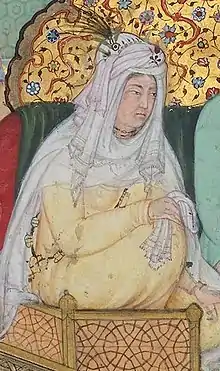 |
Börte | Genghis Khan | [65] |
| Khulan Khatun | [66] | ||
| Yesugen | [67] | ||
| Yesui | [67] | ||
| Ibaqa Beki | [67] | ||
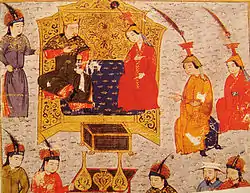 |
Sorghaghtani Beki | Tolui | [68] |
| Möge Khatun | Ögedei Khan | [69] | |
| Töregene Khatun | [70] | ||
| Oghul Qaimish | Güyük Khan | [71] | |
Ilkhanate (1256–1357)
| Portrait | Name | Monarch | Notes |
|---|---|---|---|
 |
Doquz Khatun | Hulagu Khan | [72] |
| Buluqhan Khatun | Abaqa Khan Arghun Khan |
[73] | |
| Kököchin | Ghazan | [74] | |
| Uljay Qutlugh Khatun | Abu Sa'id Bahadur Khan | [73] | |
| Baghdad Khatun | [75] | ||
| Dilshad Khatun | [76] | ||
Jalayirid Sultanate (1335–1432)
| Portrait | Name | Monarch | Notes |
|---|---|---|---|
| Dilshad Khatun | Hasan Buzurg | [76] | |
Timurid Empire (1370–1467)
| Portrait | Name | Monarch | Notes |
|---|---|---|---|
| Saray Mulk Khanum | Timur | [77] | |
| Gawhar Shad | Shah Rukh | [78] | |
Aq Quyunlu (1375–1497)
| Portrait | Name | Monarch | Notes |
|---|---|---|---|
| Despina Khatun | Uzun Hasan | [79] | |
| Aynışah Sultan | Ahmad Beg | [80] | |
Safavid Empire (1501–1736)
Afsharid Empire (1736–1796)
| Portrait | Name | Monarch | Notes |
|---|---|---|---|
| Razia Begum | Nader Shah | [91] | |
Qajar Empire (1794–1925)
Pahlavi Empire (1925–1979)
| Portrait | Name | Monarch | Notes |
|---|---|---|---|
 |
Tadj ol-Molouk | Reza Shah | [105] |
 |
Turan Amirsoleimani | [106] | |
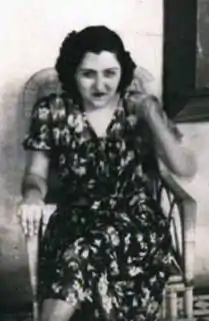 |
Esmat Dowlatshahi | [107] | |
 |
Fawzia Fuad | Mohammad Reza Shah | [108] |
 |
Soraya Esfandiary-Bakhtiary | [109] | |
 |
Farah Diba | [110] |
See also
References
- Brosius, Maria (1 January 2000). "Women i. In Pre-Islamic Persia". Encyclopaedia Iranica.
- Sciolino, Elaine (3 October 2000). Persian Mirrors: The Elusive Face of Iran. Simon and Schuster. p. 254. ISBN 978-0-7432-1453-7.
- Schmitt, Rüdiger (1987). "ASTYAGES". Encyclopædia Iranica. Retrieved 8 May 2022.
- Schmitt, Rüdiger (1 January 2000). "Mandana". Encyclopaedia Iranica. Encyclopaedia Iranica Foundation. Retrieved 6 June 2021.
- Dandamayev, Muhammad (15 December 1990). "Cassandane". Encyclopædia Iranica, Vol.V, Fasc. 1. p. 62.
- Histories of Herodotus, Book 3, 3.69
- Schmitt, Rüdiger (15 December 1987). "Atossa". Encyclopaedia Iranica, Vol. III, Fasc. 1. pp. 13–14.
- Brosius, M. (1998): Woman in Ancient Persia, p. 60, 62.
- Brosius, Maria (18 April 2006). The Persians. Routledge. p. 18. ISBN 978-1-134-35984-4.
- Longman III, Tremper; Enns, Peter (11 May 2010). Dictionary of the Old Testament: Wisdom, Poetry & Writings: A Compendium of Contemporary Biblical Scholarship. InterVarsity Press. p. 827. ISBN 978-0-8308-6738-7.
- Schmitt, Rüdiger (15 December 1993). "Damaspia". Encyclopædia Iranica, Vol. VI, Fasc. 6. p. 626.
- "Parysatis I (fl. 440–385 BCE)". Encyclopedia.com. Retrieved 16 February 2022.
- Badian, Ernst (16 November 2015). "Stateira". Encyclopædia Iranica.
- Schmitt, Rüdiger (15 December 1989). "Amestris". Encyclopædia Iranica, Vol. I, Fasc. 9. pp. 935–936.
- Dent, Susie (2012), "Atossa", Brewer's Dictionary of Phrase & Fable, Chambers Harrap Publishers, doi:10.1093/acref/9780199990009.001.0001, ISBN 978-0-19-999000-9, retrieved 16 February 2022
- Howatson, M. C. (1 January 2011), Howatson, M. C. (ed.), "Ato'ssa", The Oxford Companion to Classical Literature, Oxford University Press, doi:10.1093/acref/9780199548545.001.0001, ISBN 978-0-19-954854-5, retrieved 16 February 2022
- Daryaee, Touraj (18 August 2016), "Persian Empire", in McNeill, William H (ed.), Berkshire Encyclopedia of World History, Berkshire Publishing Group, doi:10.1093/acref/9780190622718.001.0001, ISBN 978-1-933782-65-2, retrieved 16 February 2022
- de Mauriac, Henry M. (1949). "Alexander the Great and the Politics of "Homonoia"". Journal of the History of Ideas. 10 (1): 111. doi:10.2307/2707202. ISSN 0022-5037. JSTOR 2707202.
- Anson, Edward M. (14 July 2014). Alexander's Heirs: The Age of the Successors. John Wiley & Sons. pp. 11–12. ISBN 978-1-4443-3962-8.
- O'Brien, John Maxwell (2001), Alexander the Great: The Invisible Enemy - A Biography, New York: Routledge, p. 197, ISBN 0-415-10617-6
- Photius, ibid.; Diodorus Siculus, Bibliotheca, xviii. 39
- Macurdy, Grace Harriet (1985). Hellenistic Queens. Chicago: Ares Publishers. p. 78. ISBN 0-89005-542-4.
- Strabo, Geography, xiv. 2; Stephanus of Byzantium, Ethnica, s.v. "Stratoniceia"
- Bromiley, International Standard Bible Encyclopedia: A-D p.144
- Bennett, Chris. "Berenice Phernophorus". Egyptian Royal Genealogy. Archived from the original on 11 April 2015. Retrieved 24 February 2015.
- Alten, Elif (2017). "Revolt of Achaeus Against Antiochus III the Great and the Siege of Sardis, Based on Classical Textual, Epigraphic and Numismatic Evidence". In Laflı, Ergün; Kan Şahin, Gülseren (eds.). Archaeology and History of Lydia from the Early Lydian Period to Late Antiquity (8th century B.C.-6th century A.D.). An international Symposium May 17-18, 2017 / Izmir, Turkey. Abstracts Booklet. Colloquia Anatolica et Aegaea, Acta Congressus Communis Omnium Gentium Smyrnae. Vol. IV. The Research Center for the Archaeology of Western Anatolia – EKVAM. p. 27. OCLC 6848755244.
- G. Ramsey, “The Queen and the City: Royal Female Intervention and Patronage in Hellenistic Civic Communities,” Gender & History, Vol 23, No. 3, 2011: 517.
- "Laodice IV". Livius. 4 January 2017. Retrieved 10 April 2017.
- "Laodice V - Livius". Livius.org. Retrieved 2 October 2017.
- Cleopatra Thea by Chris Bennett
- Assar, A Revised Parthian Chronology of the Period, 165-91 BCE, 2006. pg 88-112.
- J. Oelsner, “Recht im hellenistischen Babylon,” in Legal Documents of the Hellenistic World, ed. M. J. Geller and H. Maehler, London, 1995, pp. 106–148.
- Assar, Gholamreza F. (2006). "A Revised Parthian Chronology of the Period 91-55 BC". Parthica. Incontri di Culture Nel Mondo Antico. Istituti Editoriali e Poligrafici Internazionali. 8: Papers Presented to David Sellwood: 67, 74. ISBN 978-8-881-47453-0. ISSN 1128-6342.
- Sherwin-White, Susan Mary. "Laodice". Who's Who in the Classical World. Oxford Reference. Retrieved 16 February 2022.
- Strugnell, Emma (2008). "Thea Musa, Roman Queen of Parthia". Iranica Antiqua. 43: 275–298. doi:10.2143/IA.43.0.2024051. ISSN 1783-1482.
- Gignoux, Philippe (1994). "Dēnag". In Yarshater, Ehsan (ed.). Encyclopædia Iranica, Volume VII/3: Dehqān I–Deylam, John of. London and New York: Routledge & Kegan Paul. p. 282. ISBN 978-1-56859-021-9.
- Sundermann, W. (1988). "BĀNBIŠN". In Yarshater, Ehsan (ed.). Encyclopædia Iranica, Volume III/7: Banān–Bardesanes. London and New York: Routledge & Kegan Paul. pp. 678–679. ISBN 978-0-71009-119-2.
- Daryaee, Touraj (2009). "Šāpur II". Encyclopaedia Iranica.
- Muzio, Ciro Lo (2008). "Remarks on the Paintings from the Buddhist Monastery of Fayaz Tepe (Southern Uzbekistan)". Bulletin of the Asia Institute. 22: 201.
- Gross, S. (2021). "The Curious Case of the Jewish Sasanian Queen Šīšīnduxt: Exilarchal Propaganda and Zoroastrians in Tenth- to Eleventh-Century Baghdad". Journal of the American Oriental Society. 141 (2): 365–380. doi:10.7817/jameroriesoci.141.2.0365. S2CID 241531954.
- Martindale, John R., ed. (1980). The Prosopography of the Later Roman Empire: Volume II, AD 395–527. Cambridge: Cambridge University Press. ISBN 0-521-20159-4.
- Chaumont, Marie Louise (15 December 1989). "Bōrān". Encyclopaedia Iranica, Vol. IV, Fasc. 4. p. 366.
- Al-Tabari, Abu Ja'far Muhammad ibn Jarir (1985–2007). Ehsan Yar-Shater (ed.). The History of Al-Ṭabarī. Vol. V. Albany, NY: State University of New York Press. p. 404. ISBN 978-0-7914-4355-2.
- Sharon, Moshe (2013). Corpus Inscriptionum Arabicarum Palaestinae, Volume Five: H-I. Leiden and Boston: Brill. p. 286. ISBN 978-90-04-25097-0.
- Ahmed, Asad Q. (2010). The Religious Elite of the Early Islamic Ḥijāz: Five Prosopographical Case Studies. Oxford: University of Oxford Linacre College Unit for Prosopographical Research. p. 118. ISBN 978-1-900934-13-8.
- Kilpatrick, Hilary (2003). Making the Great Book of Songs: Compilation and the Author's Craft in Abū l-Faraj al-Iṣbahānī's Kitāb al-Aghānī. London: Routledge. pp. 72, 82. ISBN 9780700717019. OCLC 50810677.
- Elad, Amikam (2016). The Rebellion of Muḥammad al-Nafs al-Zakiyya in 145/762: Ṭālibīs and Early ʿAbbāsīs in Conflict. Leiden: Brill. p. 289. ISBN 978-90-04-22989-1.
- Abbott, Nabia (1946). Two Queens of Baghdad: Mother and Wife of Hārūn Al Rashīd. University of Chicago Press. pp. 15–16. ISBN 978-0-86356-031-6.
- Al-Tabari; Hugh Kennedy (1990). The History of al-Tabari Vol. 29: Al-Mansur and al-Mahdi A.D. 763-786/A.H. 146-169. SUNY series in Near Eastern Studies. State University of New York Press. pp. 148–49.
- Abbott, Nabia (1946). Two Queens of Baghdad: Mother and Wife of Hārūn Al Rashīd. University of Chicago Press. p. 25. ISBN 978-0-86356-031-6.
- Mernissi, Fatima; Mary Jo Lakeland (2003). The forgotten queens of Islam. Oxford University Press. ISBN 978-0-19-579868-5.
- al-Tabari, Muhammad Ibn Yarir (1989). The History of al-Tabari Vol. 30: The 'Abbasid Caliphate in Equilibrium: The Caliphates of Musa al-Hadi and Harun al-Rashid A.D. 785-809/A.H. 169-193. Bibliotheca Persica. Translated by C. E. Bosworth. State University of New York Press. p. 326. ISBN 978-0-88706-564-4.
- Al-Tabari; Hugh Kennedy (1990). The History of al-Tabari Vol. 29: Al-Mansur and al-Mahdi A.D. 763-786/A.H. 146-169. SUNY series in Near Eastern Studies. State University of New York Press. pp. 148–49.
- Madelung, Wilferd (2000). "Abūʾl ʿAmayṭar the Sufyānī". Jerusalem Studies in Arabic and Islam. 24: 327–343.
- al-Tabari & Bosworth 1989, p. 326.
- Classical Poems by Arab Women: A Bilingual Anthology, ed. and trans. by Abdullah al-Udhari (London: Saqi Books, 1999), p. 120; ISBN 086356-047-4.
- Rekaya, M. (1991). "al-Maʾmūn". In Bosworth, C. E.; van Donzel, E. & Pellat, Ch. (eds.). Encyclopaedia of Islam. Volume VI: Mahk–Mid (2nd ed.). Leiden: E. J. Brill. p. 331. ISBN 978-90-04-08112-3.
- Ibn al-Sāʿī (2017). Consorts of the Caliphs: Women and the Court of Baghdad. Introduction by Julia Bray, Foreword by Marina Warner. New York: New York University Press. p. 23. ISBN 978-1-4798-0477-1.
- Ibn al-Sāʿī 2017, p. 53.
- Busse, Heribert (1975). "Iran under the Buyids". In Frye, Richard N. (ed.). The Cambridge History of Iran, Volume 4: From the Arab Invasion to the Saljuqs. Cambridge: Cambridge University Press. p. 293. ISBN 0-521-20093-8.
- Gibb, Hamilton Alexander Rosskeen (1954). The Encyclopedia of Islam, Volume 6. Brill. p. 482. ISBN 978-9-004-08112-3.
- Mernissi, Fatima; Mary Jo Lakeland (2003). The forgotten queens of Islam. Oxford University Press. ISBN 978-0-19-579868-5.
- İslâm Ansiklopedisi, volume: 24, page: 93
- Bosworth, C. Edmund (6 March 2009). "Terken Ḵātun". Encyclopaedia Iranica.
- Ratchnevsky, Paul (1991). Genghis Khan: His Life and Legacy. Blackwell Publishing. pp. 164–165. ISBN 0-631-16785-4.
- Weatherford, Jack (2010). The Secret History of the Mongol Queens: How the Daughters of Genghis Khan Rescued His Empire. New York, NY: Broadway Paperbacks. p. 28. ISBN 978-0307407160.
- Broadbridge, Anne F. (2018). Women and the Making of the Mongol Empire. Cambridge: Cambridge University Press. pp. 81–4. ISBN 978-1-108-42489-9.
- C.P. Atwood Encyclopedia of Mongolia and the Mongol Empire, p. 512
- McClynn, Frank (14 July 2015). Genghis Khan: His Conquests, His Empire, His Legacy. Hachette Books. p. 117. ISBN 978-0306823961.
- The journey of William of Rubruck to the eastern parts of the world, 1253–55, p. 62
- James D. Ryan, "Mongol Khatuns" Trade, Travel, and Exploration in the Middle Ages: an Encyclopedia, ed. John Block Frieman and Kristen Mossler Figg (Garland, 2000), p. 407.
- Runciman, Steven (1987). A History of the Crusades. Cambridge University Press. p. 299. ISBN 978-0-521-34770-9.
- Charles, Melville. "BOLOḠĀN KĀTŪN: Boloḡān Ḵātūn "Moʿaẓẓama"". Encyclopaedia Iranica. Retrieved 8 March 2018.
- Geraldine Barnes; Gabrielle Singleton, eds. (11 December 2008). Travel and Travellers from Bede to Dampier. Cambridge Scholars. pp. 148–149. ISBN 9781443802321.
- Charles, Melville; Zaryab, Abbas. "CHOBANIDS". Encyclopaedia Iranica. Retrieved 10 March 2018.
- Ghiyās̲ al-Dīn ibn Humām al-Dīn Khvānd Mīr (1994). Habibü's-siyer: Moğol ve Türk hâkimiyeti. Harvard University. p. 125.
- Veit, Veronika, ed. (2007). The role of women in the Altaic world : Permanent International Altaistic Conference, 44th meeting, Walberberg, 26-31 August 2001. Wiesbaden: Harrassowitz. p. 149. ISBN 9783447055376.
- Manz, Beatrice Forbes (2002). "Gowhar-šād āḡā". Encyclopaedia Iranica. Retrieved 16 September 2014.
- Bierbrier, M.L. (1997). "The Descendants of Theodora Comnena of Trebizond". The Genealogist. Picton Press. 11 (2): 233.
- Fodor, Pál (2019). "Wolf on the Border: Yahyapaşaoğlu Bali Bey (?-1527)". In Fodor, Pál; Kovács, Nándor Erik; Péri, Benedek (eds.). Şerefe. Studies in Honour of Prof. Géza Dávid on His Seventieth Birthday. Budapest: Research Centre for the Humanities, Hungarian Academy of Sciences. p. 59.
- Savory, Roger M.; Karamustafa, Ahmet T. (15 December 1998). "Esmāʿīl i Ṣafawī". Encyclopaedia Iranica, Vol. VIII, Fasc. 6. pp. 628–636.
- Newman, Andrew J. (2008). Safavid Iran: Rebirth of a Persian Empire. I.B. Tauris. pp. 1–281. ISBN 9780857716613.
- Ghereghlou, Kioumars (22 February 2016). "Esmāʿil II". Encyclopædia Iranica.
- Parsadust, Manuchehr (2009). "PARIḴĀN ḴĀNOM". Encyclopaedia Iranica.
- Nashat, Guity; Beck, Lois (2003). Women in Iran from the Rise of Islam to 1800. University of Illinois Press. pp. 1–253. ISBN 978-0-252-07121-8.
- Kasheff, Manouchehr (2001). "GĪLĀN v. History under the Safavids". Encyclopaedia Iranica, Vol. X, Fasc. 6. pp. 635–642.
- Butler, John Anthony (2012). Sir Thomas Herbert: Travels in Africa, Persia, and Asia the Great, by Sir Anthony Herbert, Bart. ACMRS Publications. p. 403. ISBN 978-0866984751.
- Floor, Willem; Herzig, Edmund, eds. (2012). "Exploitation of the Frontier". Iran and the World in the Safavid Age. I.B. Tauris. p. 483. ISBN 978-1780769905.
- Matthee, Rudi (2012). Persia in Crisis: Safavid Decline and the Fall of Isfahan. I.B.Tauris. p. 43. ISBN 978-1-845-11745-0.
- Matthee, Rudi (30 November 2011). Persia in Crisis: Safavid Decline and the Fall of Isfahan. Bloomsbury Publishing. p. 56. ISBN 978-0-85772-094-8.
- Michael Axworthy, Sword of Persia: Nader Shah, from Tribal Warrior to Conquering Tyrant
- "Maryam Khanom". Encyclopaedia Iranica. Retrieved 29 March 2021.
- "Tavus Khanom". Institute for Iranian contemporary historical studies (in Persian). Retrieved 29 November 2016.
- Nashat, Guity (2004). "Marriage in the Qajar Period". In Beck, Lois; Nashat, Guity (eds.). Women in Iran from 1800 to the Islamic Republic. University of Illinois Press. p. 52. ISBN 978-0252071898.
- "Ağabəyim ağa Cavanşir". Adam.az. Archived from the original on 17 November 2011. Retrieved 16 September 2011.
- Newton, Michael (17 April 2014). Famous Assassinations in World History: An Encyclopedia [2 volumes]. ABC-CLIO. pp. 7–8. ISBN 978-1-61069-286-1.
- Mo'ayeri, Dustali (1982). Some notes from private life of Nasser al-Din Shah. Tehran: Nashr-e Tarikh-e Iran.
- Azad, Hassan (1999). Gosheh hai az Tarikh Egtemai-e Iran: Posht Pardeh Haram [Corners of Iran's social history: behind the scenes of the harem] (in Persian). p. 356. ISBN 9789646614000.
Nasser al-Din Shah had given her the title of Forough al-Saltanah, which at that time officially meant mistress. And Jeyran was the first to receive this title
- Mahdavi, Shireen (1 June 2009), "Anīs al-Dawla", Encyclopaedia of Islam, Three, Brill, doi:10.1163/1573-3912_ei3_com_22741, retrieved 16 February 2022
- G. Nashat, "Amīna Aqdas," Encyclopædia Iranica, I/9, pp. 954-955, accessed on 30 December 2012.
- Amanat, Abbas (1997). Pivot of the Universe: Nasir Al-Din Shah Qajar and the Iranian Monarchy, 1831-1896. I.B.Tauris. ISBN 978-1845118280.
- William Cleveland, A History of the Modern Middle East, 5th edition, Westview, 2012, p. 100.
- "Malekeh Jahan". Institute for Iranian contemporary historical studies. Retrieved 26 October 2016.
- Sheikholeslami, Mohammad Javad. Ahmad shah Qajar.
- "Diminutive Iranian princess dubbed the 'Black Panther' loved luxury". The Sydney Morning Herald. 27 January 2016. Retrieved 16 February 2022.
- Buchan, James (15 October 2013). Days of God: The Revolution in Iran and Its Consequences. Simon and Schuster. p. 46. ISBN 978-1-4165-9777-3.
- "The Marble Palace: One of The Historic Buildings, Royal Residences in Iran - Tourism news". Tasnim News Agency. 14 February 2020. Retrieved 16 February 2022.
- "The Slow Disappearance of Queen Fawzia". The New York Times. 21 December 2013. ISSN 0362-4331. Retrieved 16 February 2022.
- Meylan, Vincent (13 April 2017). "The precious jewels of Iran's 'sad-eyed' princess". CNN. Retrieved 16 February 2022.
- "Iranian Personalities: Empress Farah Pahlavi (Diba)". Iran Chamber Society. Retrieved 6 June 2021.
This article is issued from Wikipedia. The text is licensed under Creative Commons - Attribution - Sharealike. Additional terms may apply for the media files.
